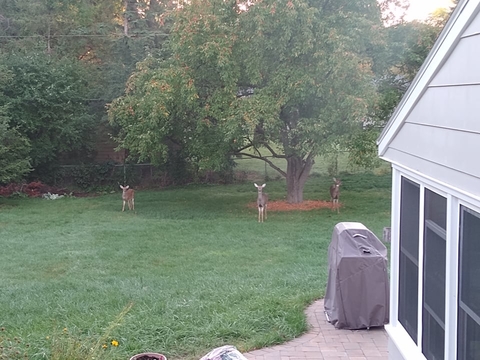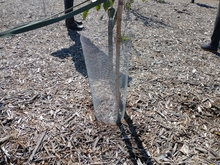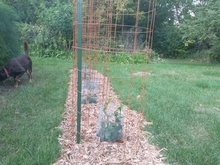The deer ate my blueberry bush!
UNIVERSITY OF MINNESOTA EXTENSION - www.extension.umn.edu
Deer frequent my backyard hoping to find tasty garden treats.
If the wildlife scene in your neighborhood is anything like mine, the only way to keep deer and rabbits off of your fruit plants is some sort of physical protection.
If I don’t imprison my newly-planted blueberries, cherry trees, and blackberries in wire fencing, they get eaten to the ground multiple times and never have a chance to grow big and strong.
In fact, deer can be so destructive to fruit trees that almost all apple orchards and vineyards in Minnesota have built 8-10 foot tall deer fences around their entire fields. Expensive? Yes. Necessary for a commercial farm? Also yes.
Fall is a great time to protect your plants from winter foraging. You can build exclusion structures at any time of the year as long as the ground is not frozen.
Small plants are most at risk
Prioritize protecting newly-planted, small fruit trees and shrubs first. If a deer eats one limb off of a new, 2-foot tall tart cherry bush, it will distort or stunt that bush for a long time. The impact of one damaged limb on a large, mature bush is less severe.
Preferred materials for wildlife exclusion
Use tight-gauge wire mesh to protect tree trunks and small fruit shrubs from rabbits.
Small mammals
To exclude low-feeding small mammals like rabbits, use a loop of sturdy small-gauge wire mesh at least 1.5 feet tall. If you get a lot of snow, you may want it to be even taller to exclude rabbits that feed atop the snow. The cage should be wider than the tree or shrub inside it, to give the plant growing space. If any leaves or twigs grow outside of their confines, assume they will get eaten.
There are a couple of ways to secure your small mesh cages to the ground. You can hold the bottoms down with 3 landscape staples. You can also install 1-2 short rebar poles or stakes per cage, and use zip ties or wire to secure the cage to the stakes.
Large mammals
Use tall, sturdy metal cages like rebar to keep deer from chewing on fruit plants as they grow.
Obviously deer feed higher than rabbits, so the exclusion material should be taller while the gauge of the wire can be wider. I recommend constructing a wide-diameter, 5-6 foot tall metal cage around young fruit plants. It should be sturdy enough that deer do not trample or get caught in it. A 5 foot long sheet of wire mesh fencing makes a cage that is about 1.5 feet in diameter. That size is ideal for young fruit shrubs like blueberry, blackberry and honeyberry; or for young (1-2 year old) newly planted fruit trees.
There are many affordable options for tall wildlife fencing to make cages for individual plants. My family uses bendable rebar wire frames called remesh. They come in sheets or rolls and are sold at home improvement stores. They are typically used in construction to stabilize poured concrete but also work great for keeping deer off of plants. You will need wire cutters to cut it, and 1 metal stake per cage to keep it from blowing over. Extra tip: Remesh makes fantastic tomato cages.
It is wise to use both the short, small mesh and the taller cage to prevent feeding by both squirrels and deer.
A caution against plastic grow tubes in winter
When it comes to protecting plants in the winter, I advise against the use of plastic grow tubes. They wrap snugly around the trunk of a tree or grapevine, creating an unwanted greenhouse effect in the winter. These types of guards effectively keep small mammals away from the trunks at the expense of the plant’s winter hardiness.
Plastic grow tubes trap in heat during the winter, increasing the daytime temperature at the trunk of the tree. But at night, the temperature plummets again once the sunlight disappears. This creates repeating cycles of warm-to-cold temperatures throughout the winter that actually de-acclimate the tree to winter temperatures. Unless the entire tree guard is under the snow for the whole winter, this phenomenon creates severe winter injury and cracking on the tree’s trunk. If you have used these in the winter without issue, that is great, but consider yourself lucky.
I hope you enjoy building protective cages around your young fruit plants and experimenting to find out what materials you like best.



